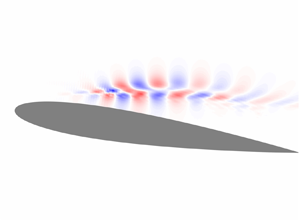Crossref Citations
This article has been cited by the following publications. This list is generated based on data provided by
Crossref.
Heide, Alexander L.
and
Hemati, Maziar
2023.
An optimization framework for analyzing nonlinear stability due to sparse finite-amplitude perturbations.
Lopez-Doriga, Barbara
Ballouz, Eric
Bae, Hyunji Jane
and
Dawson, Scott T.
2023.
A sparsity-promoting resolvent analysis for the identification of spatiotemporally-localized amplification mechanisms.
Houtman, Jelle
Vevek, U S
and
Timme, Sebastian
2023.
Identifying Active Regions of Finite-Wing Transonic Buffet using Resolvent Method.
Herrmann, Benjamin
Baddoo, Peter J.
Dawson, Scott T.M.
Semaan, Richard
Brunton, Steven L.
and
McKeon, Beverley J.
2023.
Interpolatory input and output projections for flow control.
Journal of Fluid Mechanics,
Vol. 971,
Issue. ,
Ribeiro, Jean Helder M.
and
Taira, Kunihiko
2023.
Resolvent-based analysis of low-Reynolds-number separated flows around tapered wings.
Kamal, Omar
Lakebrink, Matthew T.
and
Colonius, Tim
2023.
Global receptivity analysis: physically realizable input–output analysis.
Journal of Fluid Mechanics,
Vol. 956,
Issue. ,
Lin, Ching-Te
Tsai, Min-Lin
and
Tsai, Hsieh-Chen
2023.
Flow control of a plunging cylinder based on resolvent analysis.
Journal of Fluid Mechanics,
Vol. 967,
Issue. ,
Houtman, Jelle
and
Timme, Sebastian
2023.
Global stability analysis of elastic aircraft in edge-of-the-envelope flow.
Journal of Fluid Mechanics,
Vol. 967,
Issue. ,
Houtman, Jelle
Timme, Sebastian
and
Sharma, Ati
2023.
Resolvent analysis of a finite wing in transonic flow.
Flow,
Vol. 3,
Issue. ,
Ribeiro, J.H. Marques
Yeh, Chi-An
and
Taira, Kunihiko
2023.
Triglobal resolvent analysis of swept-wing wakes.
Journal of Fluid Mechanics,
Vol. 954,
Issue. ,
Déda, Tarcísio C.
Wolf, William R.
and
Dawson, Scott T. M.
2024.
Neural networks in feedback for flow analysis and control.
Physical Review Fluids,
Vol. 9,
Issue. 6,
Lopez-Doriga, Barbara
Ballouz, Eric
Bae, H. Jane
and
Dawson, Scott T.M.
2024.
Sparse space–time resolvent analysis for statistically stationary and time-varying flows.
Journal of Fluid Mechanics,
Vol. 999,
Issue. ,
Chu, Tianyi
and
Schmidt, Oliver T.
2024.
Mesh-free hydrodynamic stability.
Journal of Computational Physics,
Vol. 502,
Issue. ,
p.
112822.
Amiri-Margavi, Alireza
and
Babaee, Hessam
2024.
Time-dependent low-rank input–output operator for forced linearized dynamics with unsteady base flows.
Journal of Fluid Mechanics,
Vol. 1001,
Issue. ,
Gross, Andreas
Marks, Christopher
and
Sondergaard, Rolf
2024.
Laminar Separation Control for Eppler 387 Airfoil Based on Resolvent Analysis.
AIAA Journal,
Vol. 62,
Issue. 4,
p.
1487.
Mannix, Paul M.
Skene, Calum S.
Auroux, Didier
and
Marcotte, Florence
2024.
A robust, discrete-gradient descent procedure for optimisation with time-dependent PDE and norm constraints.
The SMAI Journal of computational mathematics,
Vol. 10,
Issue. ,
p.
1.
Lin, Ching-Te
and
Tsai, Hsieh-Chen
2024.
Feedback flow control on a plunging circular cylinder.
Physics of Fluids,
Vol. 36,
Issue. 4,
Rolandi, Laura Victoria
Ribeiro, Jean Hélder Marques
Yeh, Chi-An
and
Taira, Kunihiko
2024.
An invitation to resolvent analysis.
Theoretical and Computational Fluid Dynamics,
Vol. 38,
Issue. 5,
p.
603.
Heide, A. Leonid
and
Hemati, Maziar S.
2025.
Optimization framework for analyzing nonlinear stability due to sparse finite-amplitude perturbations.
Physical Review Fluids,
Vol. 10,
Issue. 1,

 $L_1$-norm, we target spatially localised structures that provide an efficient amplification in the energy of the response. We showcase this optimisation procedure on two flows: plane Poiseuille flow at Reynolds number
$L_1$-norm, we target spatially localised structures that provide an efficient amplification in the energy of the response. We showcase this optimisation procedure on two flows: plane Poiseuille flow at Reynolds number  $Re=4000$, and turbulent flow past a NACA 0012 aerofoil at
$Re=4000$, and turbulent flow past a NACA 0012 aerofoil at  $Re=23\,000$. In both cases, the optimisation yields sparse forcing modes that maintain important features of the structures arising from an SVD in order to provide a gain in energy. These results showcase the benefits of utilising a sparsity-promoting resolvent formulation to uncover sparse forcings, specifically with a view to using them as actuation locations for flow control.
$Re=23\,000$. In both cases, the optimisation yields sparse forcing modes that maintain important features of the structures arising from an SVD in order to provide a gain in energy. These results showcase the benefits of utilising a sparsity-promoting resolvent formulation to uncover sparse forcings, specifically with a view to using them as actuation locations for flow control.